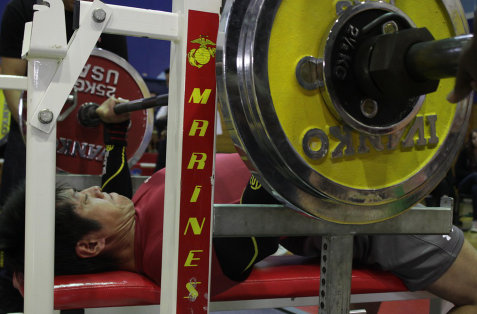Don't know how to calculate your one rep max ? Here's a formula for calculating 1 rm , recommended by a strength and conditioning coach. Use our formulas to calculate the 1 rm and find out what your magic number is. Thanks to knowing the maximum repetition you will be able to establish the appropriate percentages to ensure that you work your muscles in the most effective way possible.
Knowing your limits means you can figure out how to beat them by calculating your one rep max. But figuring out how much weight you can squat , deadlift, bench press, or military press — your one-repetition maximum (1RM) — has a use that goes far beyond mere bragging rights.
"If you're trying to add strength and muscle, whether for aesthetics or performance, then calculating your 1rm is a must," says Dr. Nicholas Gill, strength and fitness coach for the All Black rugby team. "By training at a specific percentage of your 1rm you can put a calculated amount of stress on a muscle over a certain period of time. Such specificity will create the fastest rate of muscle growth."
What is calculating the maximum repetition
- Definition 1 rm : The 1 rm or maximum repetition is the total amount of weight that we are able to move with good form to do a single repetition in a certain exercise. After performing that one repetition of maximum effort we should not be able to complete another. It is interesting to calculate the maximum force in great basic exercises such as deadlifts, squats, bench press, military press, weighted pull-ups, weighted dips or barbell rows.
The most accurate way to know your 1-rep max is to load as much weight as possible after a proper warm-up and approach. However, attempting the 1rm frequently is potentially dangerous due to the risk of injury , especially if you are a beginner. That is why the formula exists to calculate the 1 rm. Recommendation of training specialists.

Formula calculate 1 rm or how to calculate your maximum for one repetition
How to calculate my rm? Try one of the formulas that we propose.
- For your upper body or bench press:
You have to try a weight that you can do a maximum of 4 to 6 repetitions with and place it in the following formula.
(Weight for 4 to 6 repetitions x 1.1307) + 0.6998
Example:
Suppose you are able to bench press 80kg for 5 reps. We put 80 in the formula to calculate the 1 rm.
(80 x 1,1307) + 0,6998 = 91
According to the formula, your 1 rm is 91 kg .
- For the lower body (exercises like squats and deadlifts):
Here you will also have to base yourself on a weight that you can do between 4 and 6 repetitions with and put it in the formula.
(Weight for 4 to 6 repetitions x 1.09703) + 14.2546
Example:
In squat you have been able to do 5 repetitions with 90 kg. How to calculate my 1rm?
(90 x 1.09703) + 14.2546 = 113
Now that you know your approximate 1rm is 250lbs in the squat.

As you have seen, moving a weight at 5 repetitions is a relatively safe action, and it will help you estimate the weight you would move at 1 repetition thanks to the proposed formula. Calculating 1 rm is really important in designing a good training program. Based on this, you will know the weights that you have to use in your routine to achieve different objectives.
The methods we have seen are for calculating the 1 rm based on 5 repetitions . Next, we want to show you some other formulas for calculating your one rep max based on different rep ranges. But keep in mind that the further you go from 5, the result may be more inaccurate.
In addition, we recommend that after seeing the formulas you stay to read a little more . We are going to talk about the different percentages of the 1rm and what skills you will improve by training in those ranges!
Other formulas to calculate the maximum force or maximum repetitions
The ones you are going to see now are valid to know the 1 rm from any number of repetitions you do with a weight. Although keep in mind that the ideal way to get closer to the real result is that the weight you use allows you to do between 1 and 10 repetitions. For example, 4, 5... After 10 repetitions, the 1 rm estimated in the formulas will be more imprecise. In any case, keep in mind that this is approximate and that the result can vary up to 7 kg above or below the number it gives you.
For all examples we are going to use 80kg x 6 reps. If the result gives decimals, you can always round.
1995 Epley Formula RM
Perhaps it is one of the best known and used to estimate the 1 rm . Epley 's formula is:
(Weight lifted x 0.0333 x Repetitions performed) + Weight lifted
Example: (80 x 0.0333 x 6) + 80 = 96 kg of 1RM
*It is also sometimes done by multiplying only by the value 0.033.
RM formula of O'Connor et al. from 1989
O'Connor 's formula to calculate the 1 rm is as follows:
Weight lifted x (1 + 0.025 x Repetitions performed)
Example: 80 x (1 + 0.025 x 6) = 92 kg of 1RM
Gorostiaga's 1997 Formula RM
Weight lifted / (1.0278 - 0.0278 x Repetitions performed)
Example: 80 / (1.0278 - 0.0278 x 6) = 93 kg of 1RM
Download our table to calculate repetitions in Excel

For having read us this far, we would like to give you this gift. If you prefer a more direct way to estimate 1 RM, download our 1 RM calculator for Excel . It will help you calculate the rm per repetitions and will show you the approximate weights to use to get up to 12 repetitions in the main exercises: bench press, squat, row, military press ... It is very useful, since with this Excel table you will be able to point always your best maximum strength marks in those exercises.
Online calculator 1 rm and Powerexplosive's RM calculator
In case you are looking for an online rm calculator , our recommendation is that you try the one on the site https://strengthlevel.com/one-rep-max-calculator . It is much more than a web to calculate the rm; In addition to the calculator, it offers you a comparison with other lifters in the world to see your level (beginner, intermediate, advanced...). It includes tables with the strength standards for men and women, you can register to track your training... Although it is in English, it is very complete and we recommend it 100%.
As for the rm Powerexplosive calculator , we have not found one as such on their website. But we did come across a very interesting article with other ways to calculate my 1rm . You can read it on the Powerexplosive website .
How to calculate dumbbell rm

To calculate your dumbbell 1rm just add the weight of the two dumbbells and plug it into any of the above equations.
Important: To estimate dumbbell rm use a weight you can do 5-8 reps with, and always determine your maximum strength using the formulas. Never attempt your one rep max with dumbbells as it is one of the most dangerous and damaging things you can do in the gym. Don't even think about lifting your 1rm with dumbbells!
Calculate the maximum repetition for pull-ups and weighted dips
As with dumbbells, it's about adding. To calculate 1 rm for weighted pull-ups or dips , simply add your body weight and the weight of the weight you are using. Put the number in the formulas to calculate the rm.

Thanks to the 1 RM we can know what weights to use for maximum repetitions in other ranges
Knowing your one-rep max is especially helpful in designing your training programs . For example, if a routine requires working with certain percentages of the 1 rm, we will know what weights to use. Or also what weights to handle according to the repetitions indicated by a routine.
Suppose that the formula has given us an estimated rm of 92 kg in the bench press, and that a routine asks us to do 4 sets of 10 repetitions. To facilitate the task, we have left a table below where you can see the number of maximum repetitions that you could get with each percentage of the 1 rm.
The table tells us that we would be able to do 10 repetitions with 75% of our 1 rm. Thus, 92 kg x 75% = 69 kg.
If our estimated 1rm was 92kg, that means at 69kg we would be able to do 10 reps. Of course, if the table asks us to do 4 sets of 10, with that weight we will most likely not be able to complete all 4 sets. So, in order not to fail, we recommend going to a weight that allows us to do more than 10. For example, with 67% of the rm we could do 15 repetitions according to the table.
92kg x 67% = 61.5kg; With this weight we would complete 4 series of 10 repetitions without problems.
Take a look at the table and read on later, as we are going to talk about the abilities that we can train at different percentages of the maximum repetition.
| Reps | % 1 RM |
| 1 | 100% |
| 2 | 97% |
| 3 | 94% |
| 4 | 92% |
| 5 | 89% |
| 6 | 86% |
| 7 | 83% |
| 8 | 81% |
| 9 | 78% |
| 10 | 75% |
| 11 | 73% |
| 12 | 71% |
| 13 | 70% |
| 14 | 68% |
| 15 | 67% |
| 16 | 65% |
| 17 | 64% |
| 18 | 63% |
| 19 | 61% |
| 20 | 60% |
| 21 | 59% |
| 22 | 58% |
| 23 | 57% |
| 24 | 56% |
| 25 | 55% |
| 26 | 54% |
| 27 | 53% |
| 28 | 52% |
| 29 | 51% |
| 30 | 50% |
50% of your 1RM improves explosive strength
"If you want to improve the rhythm and speed of your muscles on the sports field, this is the weight for you," says Gill. "It's especially good for those who need to move really fast, like boxers."
How to use it: The perfect combination for every athlete is to do 3-6 sets of 3-4 fast explosive repetitions . Use a weight that is 50% of your 1RM . This will condition your muscles to be strong, explosive and fast without gaining too much size, bulk and slowness - the hallmarks of a well-athletic athlete.
Between 60 and 70% of your 1RM improves endurance
"This is good for long-distance athletes, as it trains their muscles to keep moving while moving moderate loads," says Gill.
How to use it: If you are an endurance athlete or just want to lose weight, then use weights in non-resting circuits consisting of 4-10 exercises. Do 12 to 20 reps . This burns calories and increases your metabolism for up to 12 hours after exercise.
Between 70% and 80% of your 1RM is best for muscle growth
"A heavy weight but one that allows you to do a certain number of reps," says Gill. "This will stress your muscle fibers enough to force them to gain size and grow."
How to use it: This is standard weightlifting practice, so you should do 7-12 reps so you can put enough stress on your muscles to force them to grow. The key here is a short rest period of 30 to 60 seconds to exhaust the muscle. These ranges are ideal for bulking.
90% of your 1RM improves power
"If you want to build maximum strength quickly, then you need to move heavy loads with speed," says Gill. "High-performance athletes use this type of training.".
How to use it: During each rep, accelerate the bar as fast as possible while keeping it in control with good form. Just do 3-4 reps and then take a 2-3 minute break to recover. Perform between 3-4 series.

95% of your 1RM to build strength
"The highest level of strength development, this weight will take you beyond your former limits in the shortest amount of time."
How to use it: Always use safety stands or have a spotter watch you and only do 1-3 reps per set to avoid injury. You should only train with such a heavy load for 6-12 weeks straight; beyond that your nervous system will begin to fatigue, which can lead to you feeling unwell and requiring some time off.
*Formulas created by the University of New Mexico.
We hope that you have finally learned the formula to calculate your 1 rm . If you have learned something with us, don't forget to keep coming back here to read other articles of interest. Calculating the 1 rm in Excel is just one of the tricks that we are going to teach you, in other posts you will learn how to calculate body fat or what is the maximum strength that you could gain being natural .
Give us your support on social networks!




![CÓMO MONTAR UN GIMNASIO EN CASA CON POCO PRESUPUESTO [GUÍA 2024]](/modules//smartblog/images/296-home-small.jpg)




